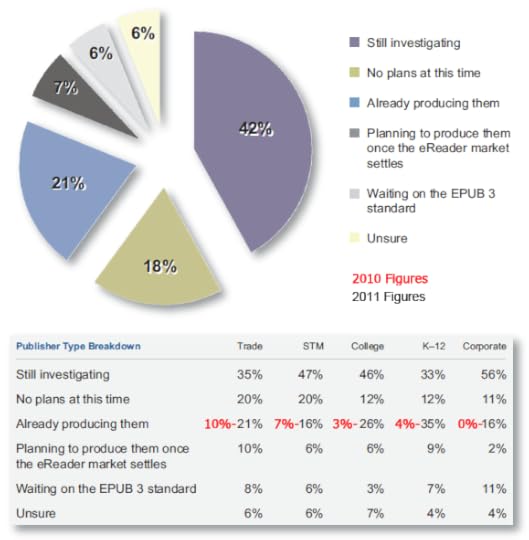Aptara Survey Addendum - Enhanced Ebooks

Breakdown of Enhanced eBook development among publishers
[Credit: Aptara Corp., "3rd Annual eBook Survey of Publishers," September 2011]
I meant to point this out the other day when I posted the Aptara survey infographic, but somehow missed adding it. This is just as well, as I feel it's significant enough to deserve a separate mention of its own. At least to those of us who are working to create graphic novels and stories with interactive elements that push the boundaries of what a book has been.
Ebooks have come a long way in a few short years, but one of the areas where they haven't even begun to reach their full potential is with regards to enhanced content. Aside from the sheer newness of the medium for many publishers, one of the main reasons for this is because thus far the major focus has been in converting print books to digital, in essence creating digital equivalents of printed books. Consequently, the major effort has been to develop digital editions that resemble print, that replicate printed books in electronic form, right down to the fake book edges and page turns found in iBooks.
While this is perfectly fine, particularly in converting previously published works, and has greatly helped to ease what has often been a difficult transition for many readers, it has at the same time limited the creative vision of what an electronic book can do going forward. Only now are content creators beginning to throw off the shackles and blinders that have restricted their imagination. Beyond just adding in some bonus video and audio content, electronic formats are capable of transcending the parameters of what a book has been until now. In the future, books will encompass a much broader spectrum of media, including such possibilities as networked interactive input from globally located readers, or books without boundaries, literally, in which the pages might turn in any direction, rather than just left to right, depending on where the reader wants the story to go. Adding factors such as geolocation and algorithmic adaptation can produce books that are different for each reader (or group of readers) each time they are read. The possibilities are virtually endless.
But first you must start somewhere. And for now, that's mainly been restricted to adding in some audio content and a couple of videos in between the standard lines of text. Cookbooks, travel guides, and other non-fiction works are the main place this is happening, aside from read-to-me features of children's books and a handful of pretty cool digital adaptations of classics such as Bram Stoker's Dracula, H.G. Wells' War of the Worlds, and a couple of rather curious Alice in Wonderland innovations. Most of these have been done as apps because ebook formats themselves haven't had the capability to produce them ... until now. With ePub 3 (and presumably KF8 to an as-yet unknown degree), the underlying HTML5/CSS3 coding incorporates the needed features of multi-layer, graphic intensive projects that enhanced ebooks inevitably entail, giving ebooks at last the possibilities of scripted content that websites have long had.
But one thing at a time. The chart above is taken from the recent Aptara survey discussed a few posts ago, and shows the rate of enhanced ebook development among the various publishing sectors. The key factor is the percentage of publishers who are now producing them, to which I have added (in red) last year's figures for reference. As you can see, the highest rate of production is in the education field, with K-12 publishers shifting in a single year from 4% to a 35% rate of adoption. This is likely due to the read-to-me feature and simple graphic interactivity being naturally suited to children's picture books such as those by Dr. Seuss, although more complex textbooks and scientific manuals have increased in production by quite a large margin as well. The Trade sector, which a year ago led the pack at 10%, has in the meantime fallen behind in its adoption rate, merely doubling its pace to 21%.
Overall, a whopping 42% of publishers say they're still investigating enhanced ebooks, with another 18% having no plans at all to begin producing them. Certainly, a large number of publishers never will, as the content they produce is not conducive to much more than basic black on white (although such enhancements as video interviews or embedded audio tracks for the visually impaired could be useful anywhere - and technically even hyperlinks and built in dictionaries are enhanced features not found in print editions, but who's counting?). A majority of the market will likely remain books built out of words and nothing more, at least for a time. But for those of us looking to develop extra features for our stories and bridge the gap between a broad array of multimedia experiences, these numbers are indicative of the state we're in: a tentative beginning in which only the first few steps have yet been taken.

Published on December 17, 2011 19:52
No comments have been added yet.



